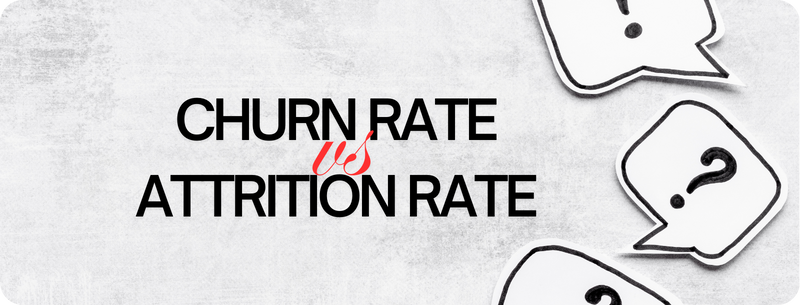In the world of associations and membership organizations, two metrics frequently come up: churn rate and attrition rate. Understanding these can make a significant difference in how you manage your community, retain members, and ensure the smooth running of your organization.

Why do these metrics matter so much? Well, they offer insights into the health of your community and the satisfaction of both your members and employees. Ignoring them can lead to dwindling membership numbers, unhappy staff, and ultimately, a struggling organization. So, let’s dive into what churn rate and attrition rate are all about and why they’re crucial for your success.
Defining Churn Rate and Attrition Rate
What is Churn Rate?
Churn rate, simply put, is the percentage of members who leave your organization over a specific period. Imagine you start the year with 1,000 members, and by the end of the year, 200 of them have left. Your churn rate would be 20%. It’s a vital metric for any membership organization because it tells you how well you’re retaining your members.
For membership organizations, a high churn rate can signal problems. It might mean your members aren’t finding enough value in what you’re offering or that your engagement strategies aren’t working. Keeping an eye on this rate helps you identify issues early and take action to improve member retention.
What is Attrition Rate?
Attrition rate, on the other hand, measures the rate at which employees leave an organization. It’s calculated similarly to churn rate but focuses on staff turnover. For instance, if you have 100 employees at the beginning of the year and 10 of them leave by the end, your attrition rate is 10%.
In the context of associations, this metric is crucial because high employee turnover can disrupt operations and lower morale. If staff are constantly leaving, it might indicate problems such as poor management, lack of career development opportunities, or an unhealthy work environment. Understanding your attrition rate helps you address these issues and build a more stable and satisfied workforce.
Key Differences Between Churn Rate and Attrition Rate
Customer vs. Employee Focus
The primary difference between churn rate and attrition rate is who they’re measuring. Churn rate is all about your customers or members – the people who use your services or participate in your community. It’s a reflection of how well you’re keeping them engaged and satisfied. If your members are leaving, it’s a sign that you need to reevaluate your offerings and engagement strategies.
Attrition rate, however, is focused on your employees. It’s a measure of staff turnover and provides insights into how well you’re managing and supporting your team. High attrition rates can be a red flag, indicating issues that need to be addressed to maintain a stable and productive work environment.
Measurement Methods
Calculating these rates is straightforward but essential for effective management.
For churn rate, you divide the number of members who left during a specific period by the total number of members at the start of that period. For example, if you started with 1,000 members and 200 left, your churn rate would be (200/1000) x 100 = 20%.
Attrition rate is calculated similarly. Take the number of employees who left during a period and divide it by the average number of employees during that period. For example, if 10 out of 100 employees leave, your attrition rate is (10/100) x 100 = 10%.
Understanding these calculation methods helps you keep track of these crucial metrics and take timely action to improve both member retention and employee satisfaction.
Impact on Membership Organizations
When you’re running an association or a membership organization, understanding churn and attrition rates can significantly impact your long-term success.
- How High Churn Affects Community Growth
High churn rates can be a major roadblock to growing a vibrant community. Imagine pouring resources into recruiting new members only to watch them leave shortly after joining. It’s like trying to fill a bucket with a hole in it. High churn means you’re constantly back at square one, struggling to maintain your membership numbers, let alone grow them.
- How High Attrition Affects Organizational Stability
On the flip side, a high attrition rate among employees can disrupt the stability of your organization. When staff members frequently leave, you lose valuable knowledge and experience, which can hinder your operations and member services. It can also lower morale among remaining employees, who may feel overworked and uncertain about their future with the organization.
Developing Retention Strategies
It’s clear that different strategies are needed to address member churn and employee attrition.
Why Different Strategies are Needed for Members vs. Employees
Members and employees have distinct needs and motivations. Members are looking for value, engagement, and a sense of community. Employees seek a supportive work environment, career growth opportunities, and fair compensation. Therefore, your retention strategies need to be tailored accordingly. For members, focus on enhancing their experience and engagement. For employees, prioritize creating a positive work culture and providing development opportunities.
Common Causes of High Churn Rate
Understanding why members leave is the first step in addressing high churn rates.
- Member Dissatisfaction
If members don’t feel they’re getting enough value from their membership, they’re likely to leave. This could be due to lack of relevant content, insufficient networking opportunities, or poor overall engagement. Members need to feel that their investment is worthwhile and that they are gaining tangible benefits.
- Better Alternatives
Sometimes, members leave because they find better alternatives. This could be another organization offering more value, better services, or more engaging activities. Keeping an eye on your competitors and continuously improving your offerings can help mitigate this risk.
- Lack of Connection
Members who don’t feel connected to the community are more likely to churn. Building a strong sense of belonging is crucial. This can be achieved through regular, meaningful interactions, fostering relationships among members, and creating a welcoming and inclusive environment.
Common Causes of High Attrition Rate
- Negative or Toxic Work Culture
One of the leading causes of high employee attrition is a negative or toxic work culture. If the work environment is filled with gossip, favoritism, or lack of respect, employees will be quick to leave. No one wants to spend their days in a place where they feel undervalued or mistreated. A toxic culture can spread like wildfire, leading to widespread dissatisfaction and high turnover rates.
- No Clear Path for Career Advancement
Employees are more likely to stay with an organization if they see a clear path for career advancement. When there’s no room for growth, or if promotions and raises are few and far between, employees may start looking for better opportunities elsewhere. People want to feel like their hard work will pay off and that they have a future within the company. Lack of professional development programs and opportunities to learn new skills can also contribute to high attrition rates.
- Ineffective Leadership and Support
Management plays a crucial role in employee retention. Poor management can lead to a host of problems, including lack of direction, inadequate support, and unclear expectations. Employees want leaders who inspire them, provide clear guidance, and support their professional development. When management fails to do this, employees can become frustrated and disengaged, leading them to seek employment elsewhere.
Strategies to Reduce Churn Rate
- Enhance Member Engagement
To keep members engaged, you need to offer activities and content that resonate with their interests and needs. Regular webinars, workshops, and exclusive content can provide significant value. Make sure these offerings are not only informative but also interactive and engaging. The more your members feel they are gaining from their membership, the less likely they are to leave.
- Improve Member Support
Excellent member support is crucial for reducing churn. Ensure that your customer service team is responsive, helpful, and easily accessible. Members should feel that their concerns and issues are being addressed promptly and effectively. Providing a personal touch and showing genuine interest in resolving their problems can go a long way in retaining members.
- Creating a Sense of Belonging Among Members
Building a strong community where members feel they belong is essential. Facilitate networking opportunities, both online and offline, where members can connect, share experiences, and support each other. Encourage members to participate in forums, social media groups, and community events. The stronger the community bond, the less likely members are to leave.
Strategies to Reduce Attrition Rate
- Building a Positive and Inclusive Environment
Creating a positive and inclusive workplace culture is key to retaining employees. Encourage open communication, recognize achievements, and promote a collaborative environment. Ensure that your workplace is a place where everyone feels valued and respected. Regular team-building activities and feedback sessions can help in maintaining a positive atmosphere.
- Training and Advancement Opportunities
Providing opportunities for career development is crucial for employee retention. Offer regular training sessions, workshops, and courses that help employees enhance their skills and knowledge. Clearly outline potential career paths within the organization and ensure that there are ample opportunities for advancement. Employees who see a future with your organization are less likely to leave.
- Effective Management Practices
Strong and effective leadership can significantly reduce attrition rates. Invest in leadership training for your managers to ensure they have the skills needed to lead their teams effectively. Good leaders should be able to provide clear guidance, support their team members, and inspire confidence. Regularly evaluate and improve management practices to maintain a high level of employee satisfaction.
Tools and Metrics for Monitoring
- Analytics for Churn Rate
Utilize analytics tools to monitor your churn rate and identify trends. Customer relationship management (CRM) systems can track member interactions, engagement levels, and retention rates. Regularly review this data to identify areas where you can improve your member retention strategies. Metrics such as member lifetime value and engagement scores can provide deeper insights into your community’s health.
- HR Metrics for Attrition Rate
Human resources information systems (HRIS) and other HR analytics tools can help track attrition rates and understand the underlying causes. Regular employee surveys, exit interviews, and performance reviews can provide valuable insights. Use these tools to monitor turnover patterns, identify potential issues, and implement strategies to improve employee retention.
Conclusion
Understanding and managing churn and attrition rates is crucial for the success of any association or membership organization. By regularly monitoring these metrics and implementing targeted strategies, you can improve member engagement, reduce turnover, and create a thriving community. Remember, retaining members and employees requires continuous effort and adaptation to meet their evolving needs. By staying proactive and responsive, you can ensure long-term stability and growth for your organization.




